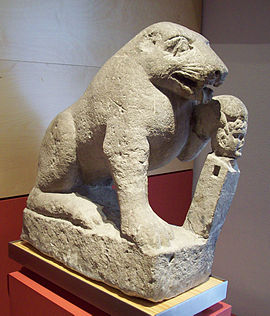The Bear of Porcuna is a sculpture dated from the 1st century BC depicting a bear or a lioness leaning on a herma. It is exhibited at the National Archaeological Museum in Madrid, Spain.
| Bear of Porcuna | |
|---|---|
| Spanish: Osa de Porcuna | |
 | |
| Year | circa late 1st century BC |
| Medium | Limestone |
| Dimensions | (79 x 70 x 32) cm |
| Location | National Archaeological Museum, Madrid, Spain |
The artifact was found in 1926 in Porcuna—the Roman Obulco—, most specifically in the calle del Sepulcro, during the building works of an oil mill.[1][2]
The animal (a bear or a lioness)[1] is depicted resting on its hindquarters.[3] The animal is leaning its front left leg on a herma, featuring a beardless male head.[1][3] The presence of the herma in the composition strongly suggests a Roman-era dating.[4] Regarding the Roman hypothesis, there are tentative datings from either the time of Augustus or somewhat later in the Julio-Claudian dynasty.[5]
It unmistakably served a funerary purpose.[1]
References
edit- Citations
- ^ a b c d Rodríguez Oliva 1982, p. 140.
- ^ Beltrán Fortes & Loza Azuaga 2005, p. 167.
- ^ a b Beltrán Fortes & Loza Azuaga 2005, p. 168.
- ^ Beltrán Fortes & Loza Azuaga 2005, p. 169.
- ^ Beltrán Fortes & Loza Azuaga 2005, pp. 169–170.
- Bibliography
- Beltrán Fortes, José; Loza Azuaga, María Luisa (2005). "El "oso de Porcuna": una escultura funeraria excepcional de la Hispania romana". Romula. 4. Seville: Universidad Pablo de Olavide. ISSN 1695-4076.
- Rodríguez Oliva, Pedro (1982). "El conjunto de hermae-retratos de Obulco" (PDF). Baética: Estudios de Arte, Geografía e Historia (5): 133–144. ISSN 0212-5099.